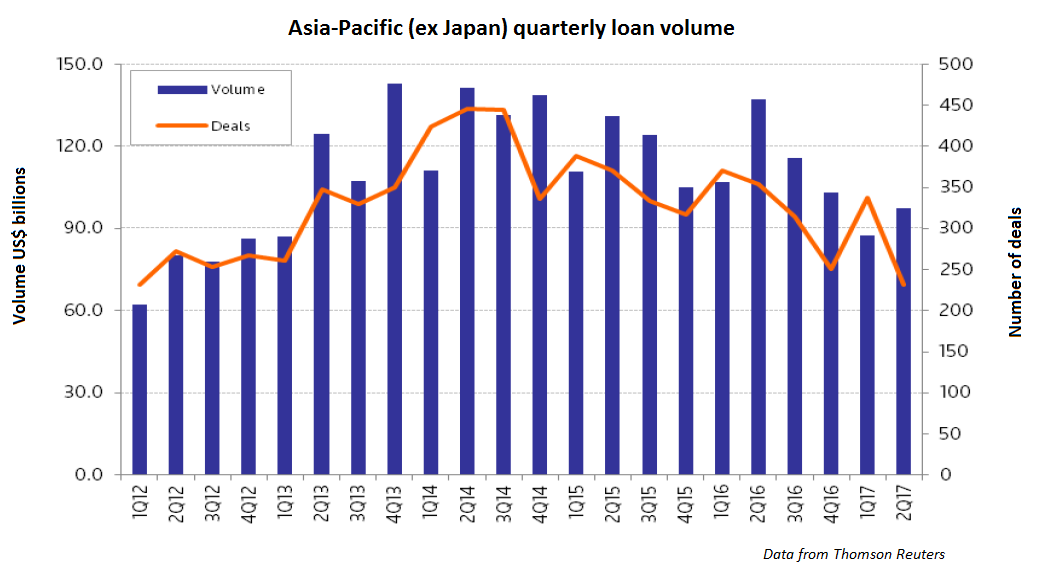The prevailing weak economic activity across Asia-Pacific continues to weigh down on the already sluggish activity in the syndicated loan markets in the region with the volume in the first half of 2017 plummeting 25% from a year ago to US$184.83 billion. The amount and the US$97.3 billion raised in the second quarter were the lowest in five years for the respective corresponding period since 2012.
According to Thomson Reuters, the deal count in the first six months of 2017 also slipped 22% to 568 transactions year-on-year, while only 231 deals were closed in the second quarter – the lowest quarterly tally in five years since the first quarter of 2012.
The declining loan volume comes as most borrowers struggled to reconcile the dismal market appetite with credit requirements. The drop in numbers was also attributed to the slowdown in China’s overseas merger and acquisition activity, which was the biggest driver in the rise of M&A loan volume in 2016.

The activity has been significantly constrained so far this year, leading to a 60.2% plunge in M&A financing in Asia in the first six months of 2017 to US$13.2 billion, compared with US$33.2 billion in the same period of 2016.
Refinancing, meanwhile, continued to account for the largest share of the loan volume, contributing more than 36% of the total issuance. However, at US$67 billion, they were down 9% year-on-year.
By country, the most active market in the first half was Hong Kong, which accounted for 29% of the regional loan volume at US$53.45 billion. The amount, however, represented a 7.8% decline from US$58 billion in the same period of 2016. The absence of local corporates and the dearth of event-driven financing pulled down the loan volume with M&A loans raising less than US$2 billion during the six-month period – or just a third of the US$5.9 billion notched in the same period last year.
China fell to second spot following a 47.5% decline in loan volume to US$45.1 billion from US$85.9 billion in the first half of 2016. Thomson Reuters says borrowings for mainland companies had already been contracting since the second half of 2016 amid the slowing economy and the government efforts to curb capital outflows that hinder the M&A activity.
This was evident from the mere US$1.6 billion in event-driven loans transacted in the first half of 2017 in China, accounting for 3.6% of the country’s total volume. In comparison, M&A loan volume from China in the first half of 2016 amounted to US$9.6 billion.
Activity in the Australia, meanwhile, has picked up as demonstrated by the healthy increase of almost 11% to US$32.6 billion in the first six months of 2017, compared to a year ago. This was underpinned by acquisition financing that contributed slightly over one-fifth of this year’s volume. It included a A$5.9 billion (US$4.5 billion) club loan involving 18 lenders to finance a consortium led by Macquarie Group in their A$7.62 billion acquisition of New South Wales power grid Endeavour Energy.
Indonesia also stood out among the loan markets in the first half of 2017 with a 14% jump from a year earlier to US$9.02 billion, with project financing accounting for the bulk of the activity.
But despite Indonesia’s strong performance and that of the Philippines and Vietnam, the total syndicated loan volume in Southeast Asia still lagged behind as it fell 23% to US$27.9 billion as the larger markets of Malaysia and Singapore registered disappointing numbers. Singapore continued to decline with volume at nearly US$14 billion, compared with US$18.8 billion in the first half of 2016, while the amount in Malaysia dropped 44% to US$2.5 billion during the same period.
Overall, the largest loan from Asia-Pacific, ex-Japan, in the first six months of 2017 was the US$5.15 billion five-year transaction for Chinese e-commerce giant Alibaba Group.
In terms of deal arrangers, the Chinese banks continued to dominate the league table for mandated arrangers in non-Japan Asia-Pacific in the first half of 2017. Bank of China was on top with volume of over US$30.05 billion for a 16.25% market share, followed by Industrial and Commercial Bank of China with US$10.72 billion (5.80%), ANZ US$8.39 billion (4.53%), HSBC US$7.70 billion (4.16%) and China Development Bank US$5.88 billion (3.17%).









